文章目录
- 官网链接
- 常用的画图函数
- 线段
- 椭圆
- 矩形
- 圆
- 箭头
- 填充多边形
- 字体相关函数
- 写字
- 得到字符串宽度和高度
- 随机数生成器:cv:: RNG
- 构造函数
- 得到随机数
- 填充特定分布的数据到矩阵
官网链接
- 链接
常用的画图函数
- 官网在 imgproc 模块下 -> Drawing Functions
- 画图函数默认的坐标方向:
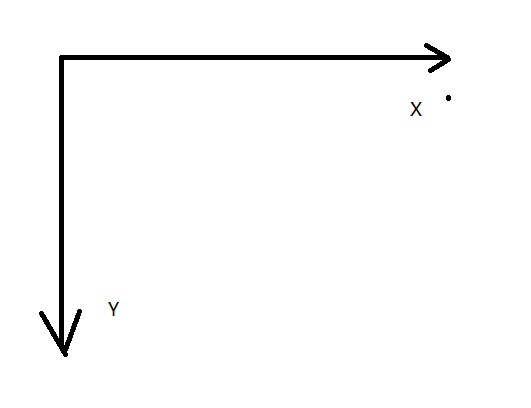
线段
- void cv::line
(
InputOutputArray img, // 在哪个图中画
Point pt1, //第一个点
Point pt2, // 第二个点
const Scalar & color, // Scalar(255,0,0) 蓝色
int thickness = 1, // 宽度,FILLED:填充
int lineType = LINE_8, // 画线的算法类型,一般选择LINE_8就行,
int shift = 0 //端点坐标小数的个数,大部分情况 0 即可
)
void MyLine( Mat img, Point start, Point end )
{
int thickness = 2;
int lineType = LINE_8;
line( img,
start,
end,
Scalar( 0, 0, 0 ),
thickness,
lineType );
}
椭圆
- void cv::ellipse (
InputOutputArray img, //目标图像
Point center, //椭圆的中心点
Size axes, //两个主轴的大小一半,下图中青色的线,相当于AXES_WIDTH,AXES_HEIGHT
double angle, //椭圆的旋转角度
double startAngle, // 画弧用的(蓝色),画弧的起始角度,如果画椭圆 就是 0
double endAngle, // 画弧用的(蓝色),画弧的结束角度,如果画椭圆 就是 360
const Scalar & color, //颜色:Scalar(255,0,0)就是蓝色
int thickness = 1, // 线的宽度,FILLED:填充
int lineType = LINE_8, // 画线的算法类型:LINE_8就行
int shift = 0 // 中心点坐标的小数位个数,大部分是整数,0即可
)
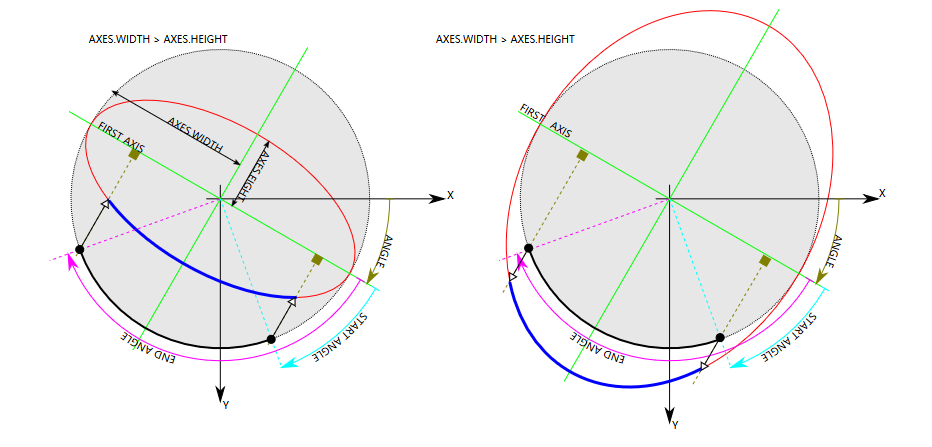
ellipse( img,
Point( 200, 200 ),
Size( 100, 50), 长轴200,短轴100
45,
0,
360,
Scalar( 255, 0, 0 ),
2,
LINE_8);
结果:图是400*400 大小
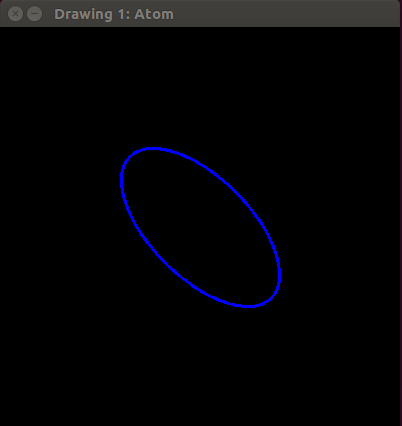
矩形
- void cv::rectangle (
InputOutputArray img, // 目标图像
Point pt1, // 矩形定点1,
Point pt2, // 矩形定点2,和1相对(对角线)
const Scalar & color, // 颜色:Scalar(255,0,0)蓝色
int thickness = 1, // 线宽度,FILLED:填充
int lineType = LINE_8, // 画线算法
int shift = 0 // 定点坐标小数点的位数,0即可
)
rectangle( rook_image,
Point( 0, 350 ),
Point( 400, 400),
Scalar( 0, 255, 255 ),
FILLED,
LINE_8 );
结果:图像大小:400*400

圆
- void cv::circle (
InputOutputArray img, // 目标图像
Point center, // 圆的中心点
int radius, // 圆的半径
const Scalar & color, // 颜色
int thickness = 1, // 线宽度,FILLED:填充
int lineType = LINE_8, //线类型
int shift = 0 // 中点,半径 的小数点个数
)
circle(img,Point(200,200),200,Scalar(0,0,255),FILLED,LINE_8);
结果:400*400的图中画了半径200的圆ff
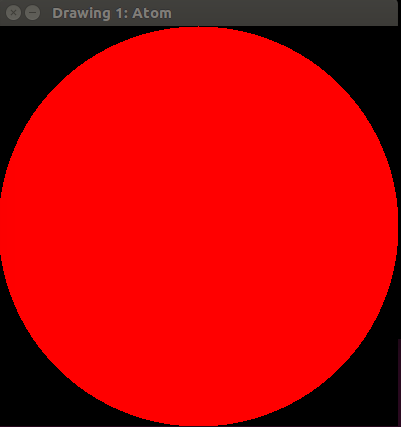
箭头
- void cv::arrowedLine (
InputOutputArray img, //
Point pt1, // 开始点
Point pt2, // 指向的 点
const Scalar & color, //
int thickness = 1, //
int line_type = 8, //
int shift = 0, //
double tipLength = 0.1 // 箭头的长度是线段的0.1
)
填充多边形
- void cv::fillPoly (
InputOutputArray img, //
const Point ** pts, //定点的首地址的二级指针
const int * npts, // 多边形定点个数
int ncontours, //
const Scalar & color, //
int lineType = LINE_8, //
int shift = 0, //
Point offset = Point() //
)
w=400;
Point rook_points[20];
rook_points[0] = Point( w/4, 7*w/8 );
rook_points[1] = Point( 3*w/4, 7*w/8 );
rook_points[2] = Point( 3*w/4, 13*w/16 );
rook_points[3] = Point( 11*w/16, 13*w/16 );
rook_points[4] = Point( 19*w/32, 3*w/8 );
rook_points[5] = Point( 3*w/4, 3*w/8 );
rook_points[6] = Point( 3*w/4, w/8 );
rook_points[7] = Point( 26*w/40, w/8 );
rook_points[8] = Point( 26*w/40, w/4 );
rook_points[9] = Point( 22*w/40, w/4 );
rook_points[10] = Point( 22*w/40, w/8 );
rook_points[11] = Point( 18*w/40, w/8 );
rook_points[12] = Point( 18*w/40, w/4 );
rook_points[13] = Point( 14*w/40, w/4 );
rook_points[14] = Point( 14*w/40, w/8 );
rook_points[15] = Point( w/4, w/8 );
rook_points[16] = Point( w/4, 3*w/8 );
rook_points[17] = Point( 13*w/32, 3*w/8 );
rook_points[18] = Point( 5*w/16, 13*w/16 );
rook_points[19] = Point( w/4, 13*w/16 );
const Point* ppt = rook_points ;
int npt = 20 ;
fillPoly( img,
&ppt, //
&npt, //多边形定点个数
1,
Scalar( 255, 255, 255 ),
LINE_8);
结果:400*400的图
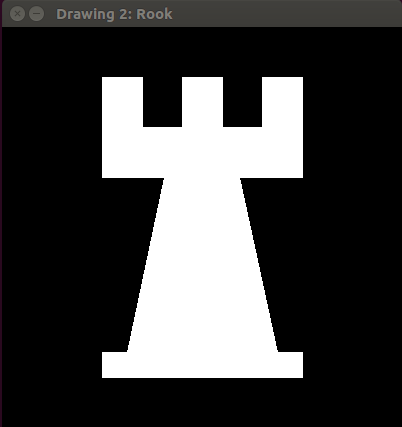
字体相关函数
写字
- void cv::putText (
InputOutputArray img, //
const String & text, // 字符串
Point org, // 右下角的坐标
int fontFace, // 字体
double fontScale, // 字的大小
Scalar color, //
int thickness = 1, //
int lineType = LINE_8, //
bool bottomLeftOrigin = false // 默认false,ture的话,字将是倒的
)
putText(img,"julian",Point(10,50),5,2,Scalar(255,0,0))
结果:
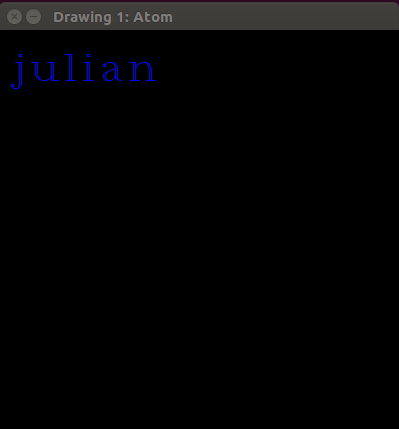
得到字符串宽度和高度
- Size cv::getTextSize (
const String & text, // 字符串
int fontFace, // 字体
double fontScale, // 字大小
int thickness, //线宽度
int * baseLine //
)
- 可以使用此函数来得到预显示的字符串的文本框大小,进行布局,比如我想将字符串放中间
int base =0;
Size textsize = getTextSize("julian",5,2,2,&base);
Point xx;
xx.x=(atom_image.cols-textsize.width)/2;
xx.y=(atom_image.rows-textsize.height)/2;
putText(atom_image,"julian",xx,5,2,Scalar(255,0,0));
结果:
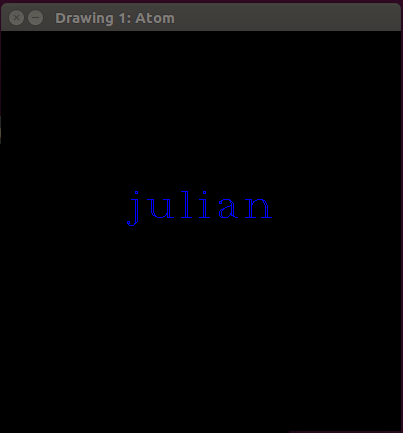
随机数生成器:cv:: RNG
- 随机数生成器都是伪随机,只要种子不变,生成的随机算法不变,每次的执行结果就是一样的。
构造函数
- cv::RNG::RNG()
- cv::RNG::RNG ( uint64 state)
RNG rng; // 第一种,默认以2^32-1 做种子
RNG rng(1);//第二种,以给定的值做种子
得到随机数
普通:
- unsigned cv::RNG::next ( ) :使用MWC算法更新种子,返回32位的随机数
- cv::RNG::operator double ( ) :返回下一个 double型的数
- cv::RNG::operator float ( ) :返回下一个 float型的数
- cv::RNG::operator schar ( ) :。。。
- cv::RNG::operator short ( ) :。。。
- 。。。。。。。。。()//都差不多
- unsigned cv::RNG::operator() ()://和next一样
- unsigned cv::RNG::operator() ( unsigned N ) ://返回的数对N取模,等价于返回 [0 N)
均匀分布:
-
int cv::RNG::uniform (
int a, // 均匀分布的下限
int b //均匀分布的上限
) -
float cv::RNG::uniform (
float a,
float b
) -
double cv::RNG::uniform (
double a,
double b
)
返回的值是int 、float、还是double只取决于传入的参数,和被赋值的左值类型无关。如果你想调用浮点数,传入的是整数,要么向a1那样进行类型转化,要么在后面加一个点
RNG rng;
// always produces 0
double a = rng.uniform(0, 1);
// produces double from [0, 1)
double a1 = rng.uniform((double)0, (double)1);
// produces float from [0, 1)
float b = rng.uniform(0.f, 1.f);
// produces double from [0, 1)
double c = rng.uniform(0., 1.);
高斯分布:
- double cv::RNG::gaussian ( double sigma )
:sigma (高斯分布的标准差 σ sigma σ),返回一个从高斯分布N(0, σ sigma σ)的采样值
填充特定分布的数据到矩阵
- void cv::RNG::fill (
InputOutputArray mat, //被填充的矩阵,
int distType, // 分布类型 RNG::UNIFORM 或者 RNG::NORMAL.
InputArray a, // 是均匀分布这个值是下限值a,是高斯分布的话就是均值
InputArray b, //是均匀分布这个值是上限值b,是高斯分布的话就是标准差 σ sigma σ
bool saturateRange = false //只对均匀分布有效,如果是ture:将会产生[ a, b ]之间的值;如果是false:最终填充的数据将会根据图像数据类型进行截断,比如传入图像是CV_C8U1:最终填充数据将是[0,255]
)
如果是多通道的图像,填充数据分别对每个通道单独进行填充,比如对3通道进行高斯分布数据填充,并不是直接由3*3的协方差矩阵形成的高斯分布,然后采样填充到图像中。而是分别形成3个高斯分布,再分别进行采样填充到3个通道。
最后
以上就是耍酷小虾米最近收集整理的关于基本绘图、随机生成器、字体的全部内容,更多相关基本绘图、随机生成器、字体内容请搜索靠谱客的其他文章。
本图文内容来源于网友提供,作为学习参考使用,或来自网络收集整理,版权属于原作者所有。








发表评论 取消回复